6 Best Grass Types for Orlando, FL
BY AMY ADAMS | MARCH 5TH, 2019 | FLORIDA, LAWN CARE, ORLANDOOrlando has so much to see and do for tourists and residents alike. But it’s not just the popular sites like Disney World that make The City Beautiful stand out – it’s also the tropical landscape. As homeowners, we do our part to hold up our nickname by maintaining our yards. Knowing the six best grass types in Orlando is a start to keeping our city’s scenery lush and beautiful.
In this article, we’ll cover:
Warm-Season vs. Cool-Season Grasses for Orlando
6 Warm-Season Grasses for Orlando
FAQ About Grass Types for Orlando
Choose Plant and Grass Varieties for Your Orlando Landscape
Warm-Season vs Cool-Season Grasses for Orlando
Living in Florida it should come as no surprise that you would want to choose a warm-season grass for your lawn. But you may still wonder, why does it even matter which grass I plant?
There are two types of grasses:
Warm-season grasses: The southern states are where you will mostly find these types of grasses. They originated in the subtropics and like cool winters and hot summers. Warm-season grasses will be at their greenest with temperatures 75-90 degrees Fahrenheit making them the ideal choice for Orlando homeowners.
Cool-season grasses: These grasses prefer cold winters and warm summers along with regular intervals of rain. They grow the most when temperatures are 65-80 degrees Fahrenheit.
With their affinity for hot weather, warm-season grass types are the obvious choice for Central Floridians. Here is some information to help you decide which of the six types of warm-season grasses is best for your Orlando yard.
6 Warm-Season Grasses for Orlando
1. Bahiagrass
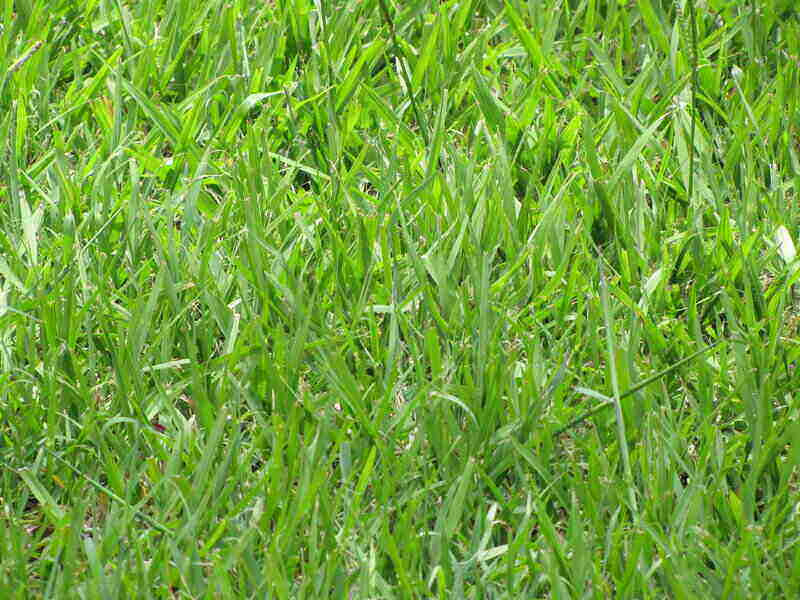
Bahiagrass
Photo Credit: Forest and Kim Starr / Flickr / CC BY 2.0
Bahiagrass may have its roots as a pasture grass, but it has made itself at home in Orlando landscapes. This fast-growing grass is tolerant of most soils but does best in acidic soil. Its resistance to most insects and diseases makes it easy to see why it’s a popular choice.
This grass is good for large spaces due to its aggressive growing rate. Because bahiagrass develops a deep root system and spreads through rhizomes (underground, stemlike roots) it easily spreads to other lawns or flower beds, so it’s best to ask a professional for advice if you live close to your neighbors.
Bahiagrass blades are typically tall and thin with a light green shade, but it also tolerates nitrogen if you desire a darker green grass. Expect to mow every seven to 10 days during the growing season.
Classification: Warm-season grass
Spreads by: Rhizomes
Shade tolerance: Low — needs full sun
Drought resistance: High
Foot traffic tolerance: Low
Maintenance needs: Growth rate is moderate to high, so plan to mow often during the growing season
Mowing height: 3-4 inches
Potential for disease: Low; insect tolerance is moderate
Soil pH: 5.5-6.5
Soil type: Tolerates most soils, does well in sandy loam
Other notes: Bahiagrass is grown in the Gulf Coast and Southeastern U.S; does best in acidic soils — not the best grass if your soils are naturally alkaline; doesn’t tolerate saltwater well
2. Bermudagrass
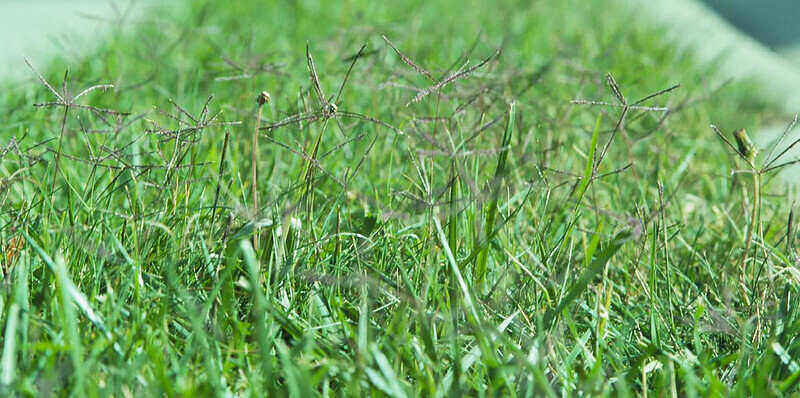
Bermudagrass
Photo Credit: Matt Lavin / Flickr / CC BY-SA 2.0
This grass with its high traffic tolerance is great if you have pets and children. It spreads through both stolons and rhizomes to help it grow into a beautiful green carpet, making it an ideal place for the kiddos to run and play. However, you will need to add metal or concrete borders at least 2 inches into the ground to prevent rhizomes from tunneling and invading nearby ornamental beds.
Its heat tolerance is perfect for our relentless hot summers and its drought tolerance is ideal for our dry springs. Bermudagrass also loves lots of sun making it the perfect Sunshine State grass.
Bermudagrass is a fine-textured grass with blades that fan out horizontally creating a soft, dense turf. It’s often used on golf courses and athletic fields. It’s a higher-maintenance grass because it requires frequent mowing and fertilizing.
Classification: Warm-season grass
Spreads by: Stolons and rhizomes
Shade tolerance: Poor — needs full sun
Drought resistance: High
Foot traffic tolerance: High
Maintenance needs: Needs frequent mowing due to fast growth rate; develops thatch easily; needs regular fertilization
Mowing height: 1-2 inches
Potential for disease: Good resistance to disease, although diseases are common; low resistance to insects
Soil pH: 6-6.5
Soil type: Tolerates most soil types
Other notes: Bermuda spreads aggressively via its stolons (above-ground stems) and rhizomes (below-ground stems) and is able to outcompete many weeds. The downside is that it also can be a nuisance and is sometimes considered invasive. You’ll often find it has tunneled underground into flower beds and spread into neighboring lawns. Tolerant of most soil types.
3. St. Augustinegrass
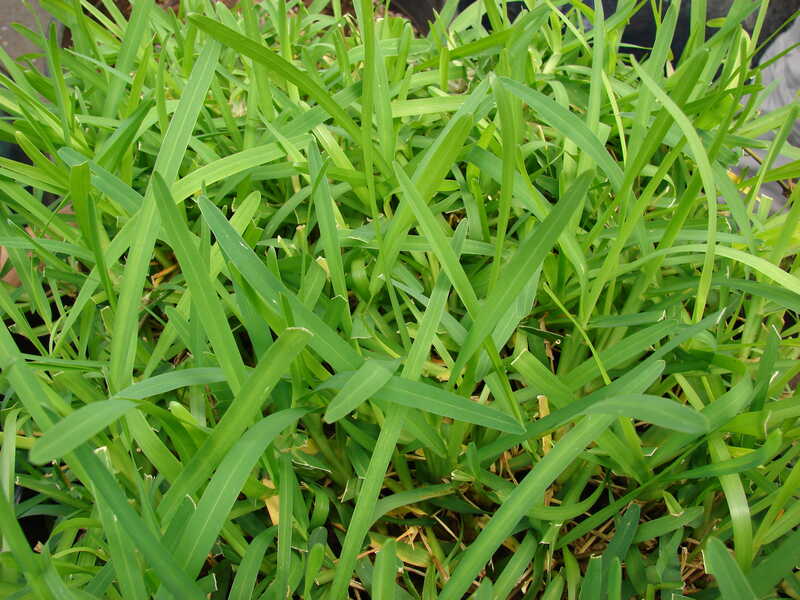
St. Augustinegrass
Photo Credits: Forest and Kim Starr / Flickr / CC BY 2.0
This high-maintenance grass needs lots of moisture and is the least cold-resistant of the warm-season grasses, making it another great option for Central Florida homeowners. Its blue-green blades are quick and easy to establish for a dense turf grass in your yard.
St. Augustinegrass’s high salt tolerance is another reason why it is a popular choice among Florida homeowners. However, it’s also known for being susceptible to disease so you do need to keep an eye out for any signs of distress.
It has a coarse and spongy texture with broad-rounded tips and doesn’t tolerate heavy foot traffic. While not a requirement, this grass performs best when fertilizer is applied regularly.
Classification: Warm-season grass
Spreads by: Stolons
Shade tolerance: Moderate shade tolerance, among the highest of any warm-season grass; some cultivars more shade tolerant than others
Drought resistance: Moderate
Foot traffic tolerance: Moderate
Maintenance needs: Moderate to high mowing frequency
Mowing height: 2.5-4 inches (mow dwarf varieties from 2.5-3 inches; standard cultivars from 3-4 inches; mow tall in shade)
Potential for disease: Moderate to high
Soil pH: 6-7.5
Soil type: Tolerates many soil types; prefers moderately fertile and moist (not waterlogged) soils; not a highly drought-tolerant grass; doesn’t tolerate soil compaction
Other notes: Native to coastal areas across the world and prefers moist soils and mild winters; will thrive in more inland areas provided growing conditions are met; good salt tolerance; will go dormant during winter in all but the southernmost regions
4. Zoysiagrass
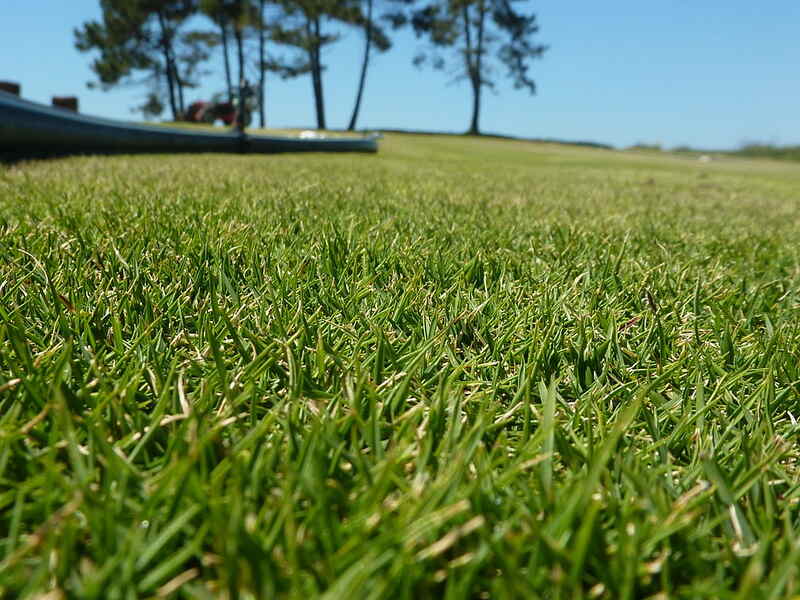
Zoysiagrass
Photo Credit: David-Pierre Mangiapan / Wikimedia Commons / CC BY-SA 3.0
This thick grass may be slow to establish but is well worth it once your yard is a full carpet of green turf. Its natural thickness helps to prevent weeds from peeking through and ruining the lawn you’ve spent so much time cultivating.
Zoysiagrass is native to Asia but has been in the U.S. since at least 1895. Its love of warm weather makes it a favorite among southern gardeners. It also grows deep roots helping it to weather a short drought. It will become dormant if there is an extended drought, but will quickly spring back to life once watered.
Keep up with proper lawn maintenance practices to keep pest problems away and your Zoysiagrass looking its best. The University of Florida details how homeowners can use best management practices, like proper fertilization, irrigation and mowing, when maintaining their Zoysia lawn.
Classification: Warm-season grass
Spreads by: Stolons and rhizomes
Shade tolerance: Tolerates light to moderate shade
Drought resistance: High
Foot traffic tolerance: High
Maintenance needs: Low to moderate nitrogen requirement; moderate mowing frequency
Mowing height: 1-2.5 inches
Potential for disease: Not prone to disease and insects; good disease tolerance overall
Soil pH: 6-6.5
Soil type: Well-draining, some cultivars more tolerant of a wide range of soils than others
Other notes: Moderately salt tolerant; cut with sharp mower blade; mow taller if grass is in partial shade
5. Centipedegrass
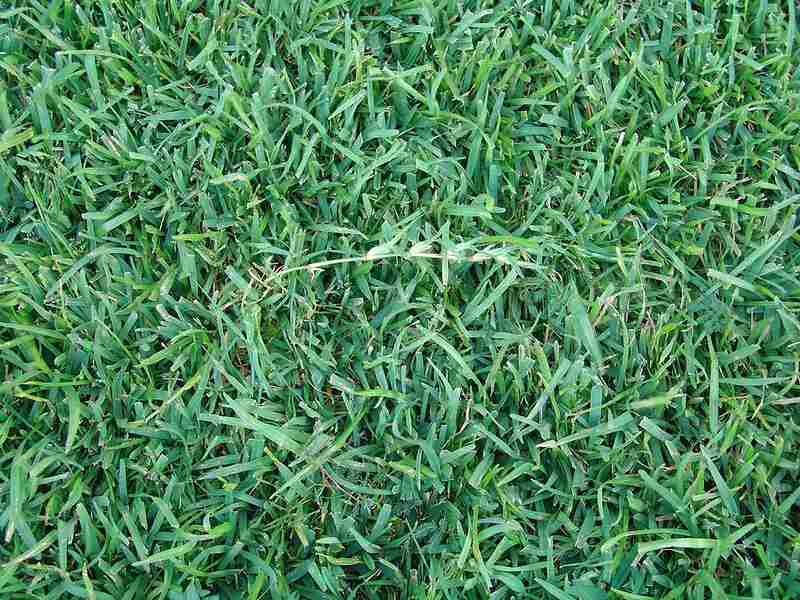
Centipedegrass
Photo Credit: James Becwar / Wikimedia Commons / CC0 1.0
This is a slow-growing grass with origins in Southeast Asia. It does well in acidic soils, is fairly drought tolerant, and even tolerates shade.
Centipedegrass is naturally a lighter green than many other grasses but homeowners are discouraged from overfertilization with nitrogen to get a darker green. You risk increasing long-term maintenance and it also reduces the grass’s ability to tolerate cold spells.
The fact that it’s a low-maintenance grass has made it a popular choice for Orlando homwoners. Centipedegrass requires less mowing than other types of grasses and is easy to edge around garden beds and sidewalks.
Classification: Warm-season grass
Spreads by: Stolons
Shade tolerance: Moderate — at least six hours of full sun per day
Drought resistance: Low to moderate
Foot traffic tolerance: Low
Maintenance needs: Low mowing frequency
Mowing height: 1.5-2 inches
Potential for disease: Good resistance to diseases and insects
Soil pH: 5-6
Soil type: Acidic, infertile, at least moderately good drainage (very dense, clay soils produce poor results)
Other notes: Low maintenance once established; greenish-yellow color (like a green apple) during the growing season; low fertilizer and mowing requirements; doesn’t tolerate heavy traffic; not a salt-tolerant grass
6. Buffalograss
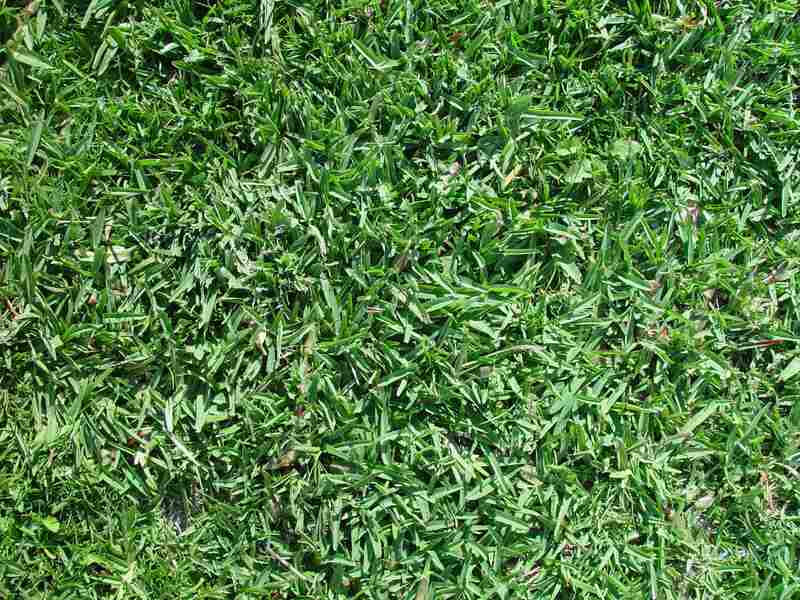
Buffalograss
Photo Credit: Titus Tscharntke / Pixnio / CC0
Spread by stolons, buffalograss derives its name from its use as a grass to feed bison and buffalo across the Great Plains in the 19th century.
Buffalograss loves what and sun, making it a great option for Central Florida homeowners. Known for its blue-green color and curling leaves, it grows well in all soil types but does not like high traffic.
This low-maintenance, low-growing grass is drought-tolerant and should only be watered as needed. Overwatering can leave your buffalograss weak and susceptible to weeds. Overwatering can also leave room for diseases to creep into your lawn.
Classification: Warm-season grass
Spreads by: Stolons
Shade tolerance: Very low — best suited for full sun
Drought resistance: High
Foot traffic tolerance: Very low, but light use or rare heavy use is OK
Maintenance needs: Low mowing frequency — once per week or less
Mowing height: 2-4 inches or leave unmowed
Potential for disease: Good tolerance against diseases and insects
Soil pH: 6.5-7.5
Soil type: Native soils, not sandy soils
FAQ About Orlando Grass Types
While you can plant grass seed year-round in Central Florida, it’s generally best to plant new seed between April and July. This will allow time for a full growing season before cold snaps begin in the late fall.
St. Augustinegrass tends to be the easiest to grow and the most popular grass in Florida due to its heat tolerance.
Yes. However, there are numerous things to consider when mixing grasses. For instance, you don’t want to choose a grass that will outgrow the other, ultimately taking over your yard. It is best to seek professional advice on the best mixes and how to care for them once planted.
Choose Plant and Grass Varieties for Your Orlando Landscape
Naturally with Orlando falling into the USDA zone 9b, you will always want to choose a warm-grass type for your Orlando landscape. But which grass you choose will largely depend on your personal preferences and needs:
If you have a shady lawn: St. Augustinegrass is an excellent option for anyone with a shady yard.
If you have a sunny lawn: Bermudagrass’s love of the sun makes this a go-to for homeowners with little to no shade in their yard.
If you have kids, pets, and guests walking on your grass frequently: You can’t go wrong with Bermudagrass when it comes to foot traffic.
The grass with the least amount of work: Centipedegrass or Zoysiagrass are the easiest to maintain.
So whether you live on the outskirts of town or in the heart of the city near Lake Eola, if you are seeking the ideal Central Florida lawn reach out to an Orlando lawn care professional to get that perfectly lush lawn that will be the talk of the neighborhood.
Main Image Credit: Orlando FL Lake / Ebyabe / Wikimedia Commons / CC BY-SA 3.0